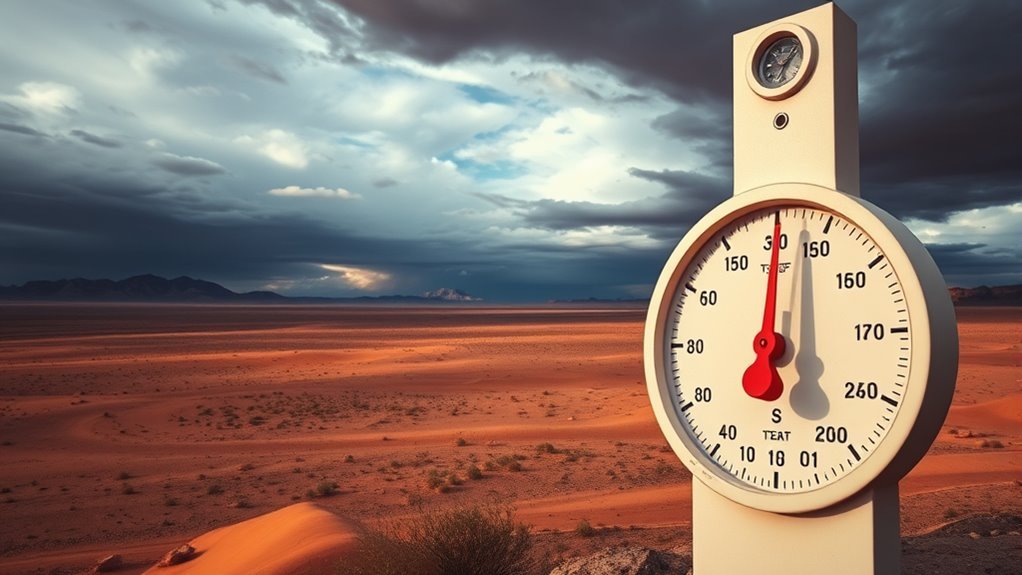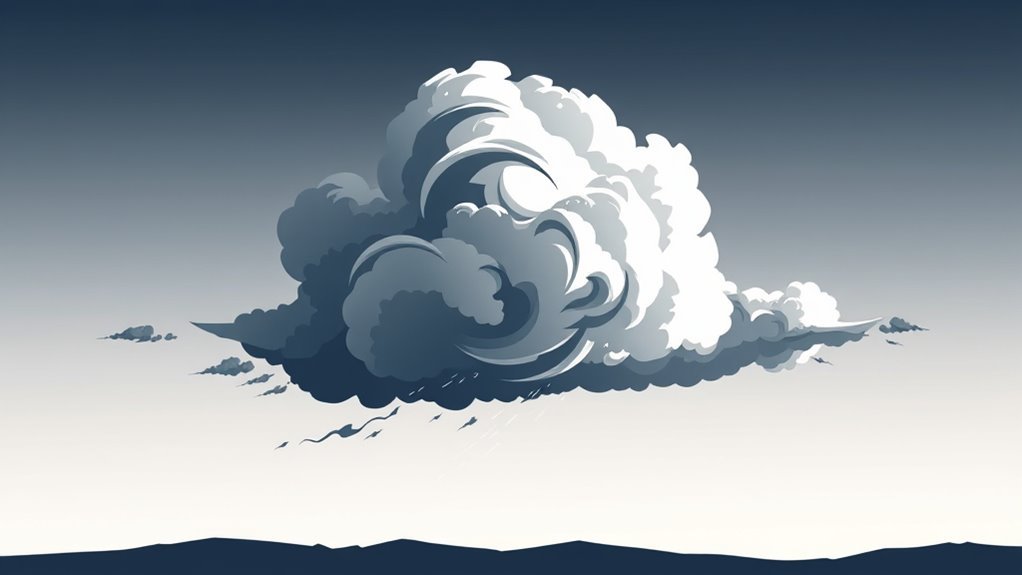Temperature and pressure play vital roles in squall development. Sharp temperature contrasts create instability, causing warm, moist air to rise rapidly. This rising air interacts with varying pressure systems, generating strong winds. Intense pressure gradients lead to powerful gusts that can accompany these storms. Consequently, squalls exhibit sudden changes in weather, often resulting in hazardous conditions. Understanding these interactions can provide deeper perspectives into the mechanics behind severe weather events and their impacts.
Main Points
- Temperature gradients create atmospheric instability, essential for squall formation by promoting convection and cloud development.
- Sharp contrasts between warm, moist air and cooler air masses lead to rapid lifting, triggering squalls.
- Pressure gradients generate winds that transport moisture and influence temperature, facilitating the development of severe weather events like squalls.
- Strong pressure differences are precursors to squalls, indicating potential for intense winds and heavy precipitation.
- Variations in atmospheric pressure and temperature impact local weather patterns, contributing to the intensity and frequency of squall events.
Understanding Squalls: Definition and Characteristics
Squalls are sudden, intense bursts of wind, often accompanied by heavy rain or thunderstorms. These meteorological phenomena can occur with little warning, making them particularly hazardous for those at sea or engaged in outdoor activities.
Characteristically, squalls are marked by a sharp increase in wind speed, sometimes reaching gale-force levels, followed by a rapid shift in wind direction. The intense winds can lead to notable wave heights and turbulent conditions, posing risks for mariners and aviators alike.
In addition to strong winds, squalls typically bring heavy precipitation, which can reduce visibility and create dangerous driving conditions. They are often associated with cold fronts or weather systems that can destabilize the atmosphere.
Understanding the characteristics of squalls is essential for meteorologists, sailors, and others who must steer through their unpredictable nature effectively. Their brief yet intense duration makes them a subject of interest in the study of severe weather phenomena.
The Basics of Atmospheric Pressure

Atmospheric pressure is defined as the force exerted by the weight of air above a given point.
It is commonly measured in units such as pascals and millibars, providing vital data for meteorological analysis.
Understanding atmospheric pressure is essential, as it greatly influences weather patterns and the development of squalls.
Definition of Atmospheric Pressure
Air pressure, a fundamental aspect of meteorology, refers to the weight of the air above a given point in the Earth's atmosphere. This pressure is essential for understanding weather patterns and phenomena, including squalls. Atmospheric pressure varies with altitude, geographic location, and weather systems.
Key characteristics of atmospheric pressure include:
- Variation with Altitude: Pressure decreases as altitude increases due to the thinning air.
- Influence on Weather: Changes in pressure can lead to different weather conditions, such as storms or clear skies.
- Measurement: While the exact measurement units will be discussed later, pressure is typically expressed in terms of force per unit area.
Understanding atmospheric pressure is important for meteorologists in predicting weather patterns and squall development.
Measurement Units Explained
Understanding how air pressure is quantified is essential for meteorologists when analyzing weather phenomena, including squalls. Atmospheric pressure is commonly measured in several units, with the most prevalent being pascals (Pa), millibars (mb), and inches of mercury (inHg).
One standard atmosphere is defined as 101,325 pascals, which is equivalent to 1,013.25 millibars or 29.92 inches of mercury. Meteorologists often prefer millibars for ease of interpretation, particularly on weather maps.
Variations in these measurements can indicate changes in weather systems, critical for forecasting squalls. Additionally, local conditions may influence pressure readings, necessitating accurate calibration of instruments.
Understanding these measurement units aids in comprehending broader atmospheric dynamics and their consequences for weather events.
Impact on Weather Patterns
Pressure gradients play an essential role in shaping weather patterns. Variations in atmospheric pressure create winds, which transport moisture and influence temperature. As air moves from high-pressure areas to low-pressure zones, it can lead to various weather phenomena, including squalls.
Understanding these pressure differentials is vital for predicting weather changes.
Key impacts of pressure gradients on weather patterns include:
- Wind Formation: Strong gradients generate powerful winds, affecting local climates.
- Precipitation Distribution: Changes in pressure can lead to varying rainfall patterns across regions.
- Storm Development: Intense pressure differences are often precursors to severe weather events, including thunderstorms and squalls.
Recognizing these connections improves the ability to forecast and respond to rapidly changing weather conditions.
The Role of Temperature in Weather Patterns

Temperature plays an essential role in shaping weather patterns through the establishment of temperature gradients and subsequent atmospheric instability.
As warm air rises, it affects the dynamics of weather systems, influencing cloud formation and precipitation.
Additionally, temperature variations can greatly impact humidity levels, further contributing to the complexity of weather phenomena.
Temperature Gradients and Instability
As atmospheric conditions evolve, the presence of temperature gradients becomes essential in determining the stability of air masses. These gradients are vital in the development of squalls, as they influence the vertical movement of air.
When notable temperature differences exist between air layers, instability can arise, leading to turbulent weather.
Key factors contributing to instability include:
- Sharp temperature contrasts: These can create strong lifting mechanisms, triggering convection.
- Low-level warm air overlaying cooler air: This configuration can improve buoyancy, promoting upward motion.
- Moisture content: High humidity levels in warmer air can further destabilize conditions, encouraging storm development.
Understanding these relationships aids meteorologists in predicting squall occurrences and their potential intensity.
Warm Air Rising Dynamics
When warm air rises, it plays an indispensable role in shaping weather patterns, particularly in the development of convective systems. This upward movement occurs because warm air is less dense than the surrounding cooler air, leading to buoyancy.
As the warm air ascends, it cools and can condense, forming clouds and precipitation. The rising of warm air also creates low-pressure areas at the surface, which can draw in cooler, denser air.
This process improves the development of thunderstorms and squall lines, as the interaction between rising warm air and descending cooler air leads to increased instability.
Consequently, the dynamics of warm air rising are vital for understanding the formation and intensity of severe weather events.
Impact on Humidity Levels
Humidity levels are complexly linked to the dynamics of warm air and its ability to hold moisture. As temperature rises, the capacity of air to retain water vapor increases, influencing weather patterns considerably. This relationship is essential in squall development, where high humidity can lead to intense precipitation and storms.
Key factors affecting humidity levels include:
- Temperature: Warmer air increases moisture retention.
- Pressure: Lower pressure can improve upward air movement, causing cooling and condensation.
- Surface Conditions: Evaporation from bodies of water or moist ground raises local humidity.
Understanding these interactions is fundamental for meteorologists predicting squall events, as fluctuations in temperature and pressure directly impact humidity and subsequent weather phenomena.
How Temperature and Pressure Interact

Understanding how temperature and pressure interact is essential for comprehending squall development. Temperature variations influence atmospheric pressure, creating gradients that drive wind patterns. When warm air rises, it expands and cools, leading to a decrease in pressure at the surface. Conversely, cooler air, being denser, exerts higher pressure. This interplay can lead to considerable changes in weather conditions, particularly during squall formation.
As warm, moist air ascends, it can lead to the development of cumulonimbus clouds, often associated with squalls. The rapid vertical movement of air creates turbulence, further affecting local pressure and temperature.
Additionally, the convergence of different air masses, defined by contrasting temperatures, can intensify pressure changes, setting the stage for squall development.
In general, understanding these interactions provides vital perspectives into the dynamics that govern severe weather phenomena, including squalls.
Conditions Favoring Squall Formation

Several factors contribute to the conditions favoring squall formation. These conditions typically arise when there is a notable contrast in temperature and humidity between air masses. The presence of a cold front is often a vital element, as it can lift warm, moist air rapidly, leading to instability.
The following conditions are particularly conducive to squall development:
- High humidity levels: Increased moisture in the atmosphere improves convective activity.
- Temperature inversions: These can trap warm air, creating a volatile environment when lifted.
- Wind shear: Variations in wind speed and direction with altitude can facilitate the organization of storms.
Understanding these factors is essential for predicting squalls, as they help meteorologists identify areas where such intense weather phenomena are likely to occur.
The Impact of Squalls on Local Weather
While squalls are often brief, their impact on local weather can be substantial and immediate. These sudden storms can lead to dramatic changes in temperature and wind patterns, often resulting in localized flooding and reduced visibility. The intense precipitation associated with squalls may overwhelm drainage systems, causing hazardous conditions that can disrupt daily activities.
Furthermore, strong, gusty winds can cause damage to trees, power lines, and structures, leading to further complications for residents in the affected area.
Squalls can also alter atmospheric conditions, influencing the development of subsequent weather systems. For instance, the cooling effect of heavy rainfall can modify local temperatures and humidity levels, creating a ripple effect that may extend beyond the immediate vicinity.
This interplay between squalls and local weather dynamics highlights the need for continued observation and study to understand these phenomena better and their broader consequences on regional climatology.
Preparing for Squall Events: Safety and Precautions
Given the notable impacts of squalls on local weather, preparing for such events becomes a pressing concern for communities. Effective preparation can mitigate risks to safety and property. Individuals should take proactive steps to guarantee they are ready when squall conditions arise.
Key precautions include:
- Stay Informed: Regularly check weather forecasts and alerts to monitor squall predictions in the area.
- Emergency Kit: Assemble a kit with essentials, including water, non-perishable food, flashlights, and first-aid supplies.
- Secure Property: Inspect and secure outdoor items that could become projectiles in high winds, such as furniture and garden equipment.
Communities can benefit from organized drills and awareness campaigns that emphasize the importance of readiness.
Common Questions
How Do Squalls Differ From Thunderstorms?
Squalls, defined by sudden wind shifts and intense precipitation, typically occur over a smaller area than thunderstorms. Unlike thunderstorms, which are often associated with lightning and thunder, squalls can develop rapidly without these phenomena.
Can Squalls Occur in Tropical Regions?
Squalls can indeed occur in tropical regions. These weather phenomena, defined by sudden changes in wind and rain, can arise due to localized atmospheric conditions, often influenced by the warm, moist air typical of tropical climates.
What Are the Warning Signs of an Approaching Squall?
Warning signs of an approaching squall include rapidly darkening skies, sudden drops in temperature, increased wind gusts, and the appearance of distant thunder or lightning. Observers may notice shifting clouds and heightened humidity levels as well.
Are Squalls More Common During Certain Seasons?
Squalls tend to be more prevalent during shifting seasons, particularly spring and autumn. Changes in weather patterns, coupled with varying temperatures and atmospheric conditions, create an environment conducive to the formation of these intense storms.
How Long Do Squalls Typically Last?
Squalls typically last from a few minutes to several hours, depending on various atmospheric conditions. Their duration can be influenced by factors such as wind patterns, moisture levels, and the surrounding weather systems.

